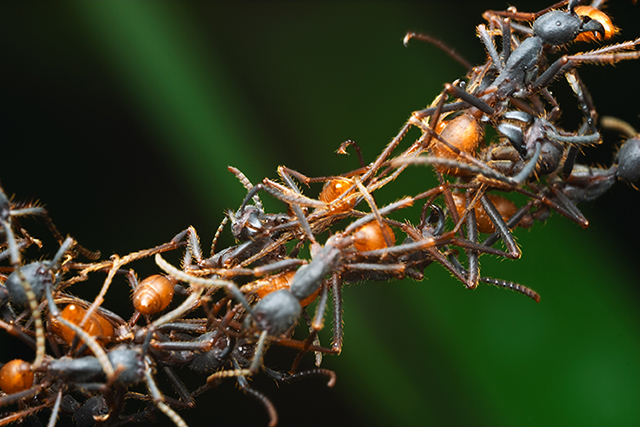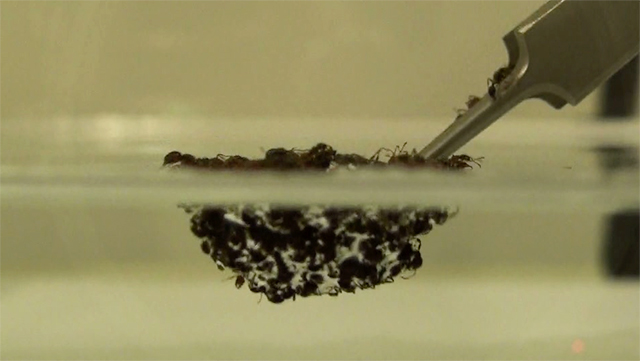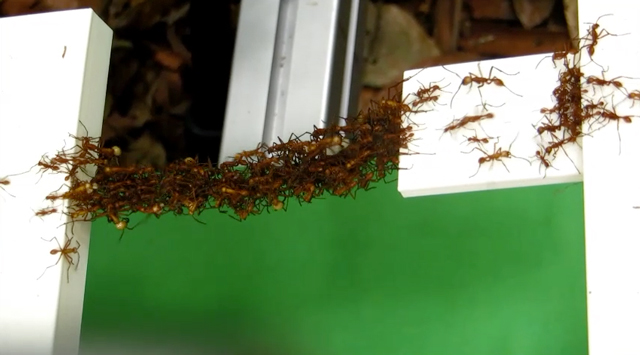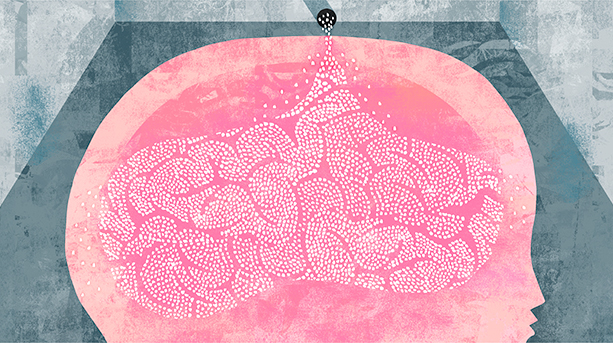The Remarkable Self-Organization of Ants

Give a colony of garden ants a week and a pile of dirt, and they’ll transform it into an underground edifice about the height of a skyscraper in an ant-scaled city. Without a blueprint or a leader, thousands of insects moving specks of dirt create a complex, spongelike structure with parallel levels connected by a network of tunnels. Some ant species even build living structures out of their bodies: Army ants and fire ants in Central and South America assemble themselves into bridges that smooth their path on foraging expeditions, and certain types of fire ants cluster into makeshift rafts to escape floods.
How do insects with tiny brains engineer such impressive structures?
Scientists have been studying the social behavior of ants and other insects for decades, searching for chemical cues and other signals that the insects use to coordinate behavior. Much of this work has focused on understanding how ants decide where to forage or build their homes. But new research combining observations of ant behavior with modern imaging techniques and computational modeling is beginning to reveal the secrets of ant construction. It turns out that ants perform these complex tasks by obeying a few simple rules.
“People are finally starting to crack the problem of producing these structures, which are either made out of soil or the ants themselves,” said Stephen Pratt, a biologist at Arizona State University. The organization of insect societies is a marquee example of a complex decentralized system that arises from the interactions of many individuals, he said.
Cracking these problems could lead to improvements in swarm robotics, large numbers of simple robots working together, as well as self-healing materials and other systems capable of organizing and fixing themselves. More broadly, identifying the rules that ants obey could help scientists understand how biologically complex systems emerge — for example, how groups of cells give rise to organs.
“Self-organizing mechanisms are present everywhere in nature, from the development of an embryo to the organization of large animal populations,” said Simon Garnier, a biologist at the New Jersey Institute of Technology.
Guy Theraulaz, a behavioral biologist at the Research Center on Animal Cognition in Toulouse, France, and collaborators have been studying insect nests for the last 20 years, building more complex and realistic models as their data improved. They have discovered that three basic guidelines governing when and where ants pick up and drop off their building materials are sufficient to create sophisticated, multilayered structures.
“It all results from local interactions between the individuals,” said Garnier, a former student of Theraulaz’s who now studies living ant bridges. “The final structure emerges without central coordination.”
Theraulaz’s team painstakingly analyzed videos of ants crawling across petri dishes as they attempted to build a shelter, noting each time that an ant picked up or dropped off a grain of sand. The researchers discovered three main rules: The ants picked up grains at a constant rate, approximately 2 grains per minute; they preferred to drop them near other grains, forming a pillar; and they tended to choose grains previously handled by other ants, probably because of marking by a chemical pheromone.
The researchers used these three rules to build a computer model that mimicked the nest-building behavior. In the model, virtual ants moved randomly around a three dimensional space, picking up pieces of virtual sand soaked in a virtual pheromone. The model ants created pillars that looked just like those made by their biological counterparts. The researchers could alter the pillars’ layout by changing how quickly the pheromone evaporates, which could explain why different environmental conditions, such as heat and humidity, influence the structure of ant nests. (They published a preliminary version of the model in a conference report in 2011 but haven’t yet published the more refined version, which better mimics real ants.)
“The real novelty here is our newly acquired ability to observe in detail the formation and the transformations of these structures,” Theraulaz said. “We finally have access to precise data on how living things get together to form complex yet fully functional and reactive structures.”
After a weeklong simulation, the virtual ants created something that looked like a real nest; layers stacked together with connections between them. The connections themselves were not explicitly written into the rules, Theraulaz said.
“For the longest time, people never would have believed this is possible,” said Chris Adami, a physicist and computational biologist at Michigan State University, who was not involved in the study. “When looking at complex animal behavior, people assumed they must be smart animals.”
Living Architecture
For David Hu and collaborators at the Georgia Institute of Technology, researching ant architecture is both a livelihood and a workplace headache. Hu’s team studies living architecture in which “ants are the bricks and the brick layers,” Hu said. But the fire ants in Hu’s lab are also adroit escape artists. They build towers to escape their enclosures and creep under locked doors. Hu is terrified of three-day weekends, which give the ants more time to break free and build bivouacs — nests made of hundreds of thousands of ants — under his colleagues’ desks. When everyone returns to work, he receives panicked calls from infested offices.
“We have ants escaping from our lab all the time,” Hu said. “The bivouacs are sophisticated, with tunnels and windows that can open and close in response to humidity and temperature.”
In his research, Hu is focused on first understanding a simpler structure — ant rafts. The insects can escape floods in their habitat by assembling into rafts made up of up to 100,000 members. The surprisingly buoyant structures, which can be as large as a dinner plate, can float for weeks, enabling the colony to survive and find a new home.
Hu and collaborators had previously shown that after a spoonful of ants is dropped into water, the blob of insects transforms into a pancakelike raft through a simple process: each ant walks randomly on the surface of the blob until it hits the water’s edge. “An individual ant can’t know how big the raft is, where it is in the raft and what other ants are doing,” Hu said. “The only communication goes on at the edge of the structure — that’s where the structure grows.” Hu’s team used these simple rules to build a virtual ant raft that had the same dynamics as one made by real ants.

Wanting to understand exactly what gives the ant rafts their remarkable strength and buoyancy, Hu’s team peeked inside the structure. They froze rafts of ants and then created images of them using computed tomography (also known as CT scans).
The findings, which will be published in an upcoming paper in the Journal of Experimental Biology, reveal that ants weave themselves into something like three-dimensional Gore-Tex, a fabric that is both breathable and waterproof. The ants form air pockets by pushing away from whichever ants they are connected to, creating highly buoyant rafts that are 75 percent air. The weave of the ant fabric is held together by multiple connections among individual ants, which orient themselves perpendicular to one another. “What’s happening at the big scale is the result of lots of interactions at the small scale,” Hu said. The result is a water-repellant lattice that enables even the ants at the bottom of the structure to survive.
As an engineer, Hu views ant conglomerates like any other material, studying their properties much as one might study plastic, steel or honey. Ants, however, have the unusual ability to act as either a liquid or a solid, and Hu hopes further research into this ability will help engineers design self-healing structures such as bridges capable of sensing and mending cracks.
To find his ant architects, Garnier sometimes spends days with his collaborators wandering the rainforest on an island in the Panama Canal. But once in close range, the target is easy to spot: Huge swaths of army ants in search of food for their voracious young sometimes cover the length and almost half the width of a football field. Ants from this nomadic species, named for their characteristic marching columns, blanket their surroundings. To expedite their relentless foraging, the ants rapidly build bridges over gaps in their path or across trees, using their own bodies as building blocks to create a smooth and expedient path for their kin. Scientists have long studied these curious creatures, exploring the evolutionary advantages of their foraging and bridge-building tactics, but Garnier and collaborators are among the first to study exactly how the structures form. They build obstacles in the path of the marching column and record the ants as they build a bridge.
Like fire ant rafts, bridges are built based on simple rules and possess surprising strength and flexibility. As soon as an ant senses a gap in the road, it starts to build a bridge, which can reach a span of tens of centimeters and involve hundreds of ants. Once the structure is formed, the ants will maintain their position as long as they feel traffic overhead, dismantling the bridge as soon as the traffic lightens. “The exact timing of their decision to join or leave the structure maximizes stability as a function of traffic on the trail,” Garnier said. “The rules of behavior in forming and dismantling the bridge are optimally designed to handle the traffic.”
Garnier’s team is now studying how individual ants cling to one another to create the structure and how ants at the fastening points can hold the weight of 100 comrades. “I think this is a new, very exciting approach,” said Bert Hölldobler, an evolutionary biologist at Arizona State University who has been studying ants for more than 40 years.
One of the most exciting findings to emerge from studies of living architecture “is how dynamic and rich this process is,” said Scott Turner, a biologist at the State University of New York College of Environmental Science and Forestry in Syracuse. Garnier’s work shows that ants build and disassemble bridges according to changing needs. Preliminary work from Hu’s group, which also studies bridges, shows that the structure’s properties, such as strength and integrity, evolve with changing conditions.

Ant Traffic
Garnier said he was inspired to examine ant behavior after studying human pedestrian traffic. “It’s a fascinating question to understand how individuals that are less cognitively able than we are can collectively achieve results that are sometimes better than what we can do with our big brains,” he said. Ants on a foraging mission are typically carrying loads two to three times their size and running at a human equivalent of 60 miles per hour. The insects avoid traffic jams by spontaneously forming three lanes of traffic, a center lane of homeward bound ants flanked by two lanes of insects heading out on the hunt. It’s unlikely that swarms of speeding humans could organize themselves so effortlessly, Garnier said. “If you removed traffic lanes in New Jersey, it would be a nightmare,” he said.
Although Hölldobler is excited about all three projects, he cautions that just because a model mimics real ant behavior doesn’t mean it reflects what’s actually happening. He cites the case of a model of desert ants that re-created their complex foraging expeditions without the need for a chemical trail marker, created at a time when scientists had found no evidence for one. But Hölldobler’s team later discovered that the insects do indeed use chemical markers, limiting the usefulness of the model.
Also currently missing is an evolutionary approach to understanding the ant behavior. “If we can understand how rules emerge from other rules and how they change with the environment, that would be extraordinarily fruitful,” said Adami, who is planning to work with Garnier on this question.
Meanwhile, engineers are already dreaming up useful applications. They hope to use ant construction principles to design modular robots that can self-organize. Adami imagines a swarm of robots sent to Mars to build a structure from Martian soil ahead of the arrival of humans. The beauty of a decentralized system is that a project can succeed even if individual parts fail.
Dynamic ant architecture might also provide insight into how to make buildings more adaptive, changing its properties based on how many people are inside, for example. To make a living building, “you need to continually monitor the environment and what effect the swarm has on the environment,” Turner said.
Ants might even shed light on the complex organization of the organ we use to study them — the brain. The behavior of an ant community resembles the organization of neurons into a functioning brain, Hölldobler said. “Each neuron is relatively dumb, but if you take billions of neurons, they interact in a way that we have only scratched the surface of understanding.”
This article was reprinted on TheGuardian.com.



